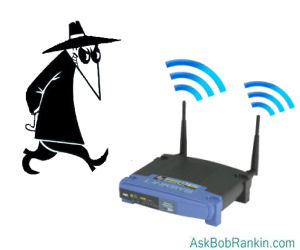ZAP Your WiFi Intruders!
Is your wireless Internet (WiFi) connection being borrowed or hijacked by a stranger? If your home WiFi connection is sometimes mysteriously slow, it might be that a neighbor, stranger (or a malicious hacker) has tapped into your wifi. It happened to me! Read on to learn how to bust bandwidth bandits, and give digital leeches the boot... |
Do You Have a Wifi Intruder?
There are many possible reasons why your wireless Internet connection might suddenly slow to a crawl. Someone else in your home may be downloading a huge file, or playing a network-intensive online game. Or it could be leeches. Of course I'm not referring to those icky bloodsucking worms, but rather an unauthorized, parasitical user stealing a portion of your wifi bandwidth.
Anyone with the skills and determination to hack your secured network is likely up to some sort of criminal activity. There are many casual, even “innocent” bandwidth moochers who see an available network and just assume it’s OK to “borrow” it. If they are challenged for a password when they attempt to log on, they'll probably just give up and move on to another target. If you haven't bothered to assign a wifi access password, the front door to your network is wide open.
At my previous address, I had Verizon FIOS Internet service installed. And soon after, I noticed cars were stopping in front my house, and staying for 10 or 20 minutes. After checking my wireless router, I found that Verizon had left it wide open. Without a wifi password, anyone could connect, and these drive-by strangers were doing just that. I locked down the router's wifi signal with a password, and my daily stream of visitors stopped.

A real cybercriminal is another matter. He is out to steal something of value from you. He may peruse computers on your network for identity and financial information he can use or sell. He may use your Internet connection to download files illegally or hack other networks, setting you up as the fall guy when the crime is traced back to your router. This sort of crook has the tools and skills needed to defeat most WiFi security measures, especially if you have a weak password.
Windows and Apple computers have built-in utilities that show what devices are connected to your network. You can use these tools to look for unknown computers that should not be connecting to your network. Obviously, the first step is to know what devices are authorized. Each authorized computer should be assigned a computer name that you can recognize easily, i.e., "Jane PC" or "Billy Laptop". Other devices, such as printers, will have built-in names such as “HP Model 8610.” A smartphone connected to your router may show as "Tim's iPhone" or "Sharon's Galaxy S20". Other common wifi-connected devices are streaming boxes (Roku, ChromeCast, FireTV) and digital assistants such as Amazon Echo and Google Home. You should be familiar with what you own.
Detecting Unwanted Wifi Connections
On Windows 10 or 11, open Control Panel, select view by Category, click "Network and Internet" then click the "view network computers and devices" link. (On Windows 7 and 8, click the Start button and type “network” in the search box. Click on the word “Network” which should be one of the first items in the search results.) A multi-part display of connected devices will appear, listing computers, media devices, network infrastructure, and other items connected to your local network. “Computers” will include PCs and Macs. “Media devices” include printers, gaming consoles, smart TVs, and the like. “Network infrastructure” includes your Internet router and/or modem. "Other Devices" will include streaming video players, such as a Chromecast or Roku.
For some reason, connected iPods, tablets and smartphones do not show up here. An unauthorized device will probably be among the “computers” listed, but if (for example) you see an Xbox that doesn’t belong to you, you obviously have an interloper. Apple OS X computers have a similar utility. You can access it via Finder > Go > Network. On a Linux computer, the nmap command will show connected devices.
Your router’s configuration program provides a better view of ALL devices connected to your network. By logging into your router, you can see a list of devices that currently have IP addresses assigned to them. Consult your router’s documentation (or Google it) to learn how to access this list. Devices that may appear in this list include desktop and laptop computers, tablets and ebook readers, iPods, smartphones, wireless printers, streaming devices such as Roku or AppleTV, gaming consoles, and television set-top boxes.

Many routers also store logs of past connections, which you can peruse to see what devices connected when you weren’t looking. If you don't know how to login to your router, or you don't know the password, ask your Internet Service Provider for help.
If you discover an unauthorized user on a secured WiFi network, my advice would be to immediately change BOTH your router login password and your wifi access password. Yes, both. And then restart your router. If the intruder re-appears, it’s time to contact your Internet Service Provider, or maybe even call the cops.
Real-Time Wifi Monitoring
None of the utilities described so far alerts you when an unauthorized device connects to your network. A third-party utility called Softperfect Wi-Fi Guard does the trick for both Windows and Apple Mac computers. Running in the background, it checks your router’s network connections list at intervals that you can set. Popup alerts tell you when a new or unknown device is detected. The free version of this program may not detect all your connected devices, but the paid version ($19) will.
Wireless Network Watcher is a similar free utility program for Windows that simply lists your connected devices. Optionally, it will beep when a device connects or disconnects from your router.
Another option is Advanced IP Scanner. This is a free network scanning tool that checks your network connections and displays all connected devices. It also gives you access to shared folders, provides remote control of computers, and can even remotely switch computers off.
If you have an iPhone or Android mobile device, the free Fing App will identify connected devices, detect network intruders and run internet speed tests.
And finally, some Internet security suites have a network monitoring feature included. One that comes to mind is Avast Antivirus. After opening the user interface, click the Protection button, then the Wi-Fi Inspector button. It does list connected devices, but doesn't identify them as clearly as other tools. My Acer desktop computer was identified as "Netgear"; an iPhone on the network was identified only as "Apple"; and my wifi-connected HP printer showed up as a "generic computer".
Your thoughts on this topic are welcome! Have you scanned your network for wifi intruders? Post your comment or question below...
|
|
|
This article was posted by Bob Rankin on 23 Apr 2025
| For Fun: Buy Bob a Snickers. |
|
Prev Article: Forgot Your Windows Password? Do This Now... |
The Top Twenty |
Next Article: Does Your Computer Need an Oil Change? |
Post your Comments, Questions or Suggestions
|
Free Tech Support -- Ask Bob Rankin Subscribe to AskBobRankin Updates: Free Newsletter Copyright © 2005 - Bob Rankin - All Rights Reserved About Us Privacy Policy RSS/XML |
Article information: AskBobRankin -- ZAP Your WiFi Intruders! (Posted: 23 Apr 2025)
Source: https://askbobrankin.com/zap_your_wifi_intruders.html
Copyright © 2005 - Bob Rankin - All Rights Reserved



Most recent comments on "ZAP Your WiFi Intruders!"
Posted by:

hifi5000
23 Apr 2025
I suggest you get to know your router well. You can type in its IP address (LAN) and see what is set up for. You should have a strong password for the router itself plus strong passwords for the actual wi-fi access as called for in Bob's article.
I have several desktops at home, so I have specific hostnames to quickly identify each one on my LAN. If there is a strange hostname I don't recognize, I can check into it.
Posted by:

chris
23 Apr 2025
What I like about "wireless network watcher" is it's ability for the user to assign identifiable names to each device. It makes it extremely easy to spot an unknown device.
Posted by:

Nomi
23 Apr 2025
I was able to find "view network computers and devices" following your instructions, but I don't know what to make of what I see there. How do you name computers and phones and printers? How do you tell what things are? I have something showing up as "manageable device." ???
Posted by:

Gia
25 Apr 2025
Namoi (and others): What this article is talking about is the Windows "Network Discovery" feature. This is far from being a reliable tool and depends on many settings to make it come close to showing everything connected to your network. Sorry, I can't explain it all here, but on Windows 10 you may have another problem of not having a feature called SMB, which will make network discovery not work. Microsoft decided to remove/disable SMB from Windows 10, but you may be able to reinstall it in the "Turn Windows features on and off".
Whatever appears on your list of devices may be named in many strange ways. Some may have names of a device manufacture. Others may have the computer name, which you should be able to see if you open This PC (Win 10) or Computer (Win 7).
Anyway, without some research and work on your part changing settings/Group Policy/Registry/Firewall this "method" described in this article isn't going to be of much help to find intruders on your network. If you're serious about that you'll need a network scanning and monitoring software.